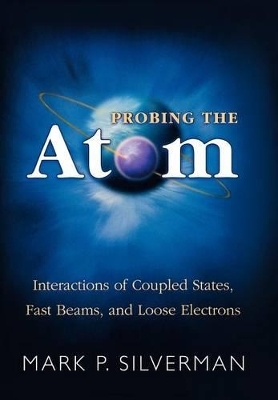
Probing the Atom
Princeton University Press (Verlag)
978-0-691-00962-9 (ISBN)
The many-faceted efforts to understand the structure and interactions of atoms over the past hundred years have contributed decisively and dramatically to the explosive development of physics. There is hardly a branch of modern physical science that does not in some seminal way rely on the fundamental principles and mathematical and experimental insights that derive from these studies. In particular, the drive to understand the singular features of the hydrogen atom--simultaneously the archetype of all atoms and the least typical atom--spurred many of the twentieth century's advances in physics and chemistry. This book gives an in-depth account of the author's own penetrating experimental and theoretical investigations of the hydrogen atom, while simultaneously providing broad lessons in the application of quantum mechanics to atomic structure and interactions. A pioneer in the combined use of atomic accelerators and radiofrequency spectroscopy for probing the internal structure of the hydrogen atom, Mark Silverman examines the general principles behind this far-reaching experimental approach.
Fast-moving protons are directed into gas or foil targets from which they capture electrons to become hydrogen atoms moving uniformly at very high speeds. During their rapid passage through the spectroscopy chamber of the atomic accelerator, these atoms reveal by the light they emit fascinating details of their internal configuration and the interactions that created them. Silverman examines the effects of radiofrequency fields on the hydrogen atom clearly and systematically, explaining the details of these interactions at different levels of complexity and refinement, each level illuminating the physical processes involved from different and complementary perspectives. Readers interested in diverse areas of physics and physical chemistry will appreciate both the theoretical and practical implications of Silverman's studies and the personal style with which he relays them. This is a work of not only an outstanding research physicist, but a fine teacher who understands how curiosity underlies all science.
Mark P. Silverman is an internationally known atomic and optical physicist with a Ph.D. from Harvard. He has held the Fréderic Joliot Chair of Physics at the Ecole Supérieure de Physique et Chimie in Paris and was the first western scientist to be Chief Researcher at the Hitachi Advanced Research Laboratory in Tokyo. He is Professor of Physics at Trinity College and author of And Yet It Moves: Strange Systems and Subtle Questions in Physics and Waves and Grains: Reflections on Light and Learning (Princeton).
Preface: In at the Beginnings xi Notes xviii Chapter I Energies and Spectral Lines 3 1.1. Anatomy of Hydrogen 3 1.2. Shapes and Widths 12 Notes 17 Chapter 2 The Driven Two-Level Atom 19 2.1. Dynamics of a Two-Level Atom 19 2.2. Rotating-Wave Approximation 23 2.3. Oscillating-Field Theory 28 2.4. Occupation Probabilities 32 Notes 42 Chapter 3 The Driven Multilevel Atom 43 3.1. Statistical Uncertainties and the Density Matrix 43 3.2. Time Evolution of the Density Matrix 46 3.3. Generalized Resonant Field Theory 48 3.4. Two-State Transitions 54 3.5. Three-State Transitions 56 3.6. Four-State Transitions 60 3.7. Numerical Solution of the N-State System 65 3.8. Coupling Elements Vuv 67 Appendix. Eigenvalues and Eigenvectors of Three- and Four-State Systems 72 Notes 76 Chapter 4 Multiple-Quantum Transitions 78 4.1. The Quantized Radiofrequency Field 78 4.2. Remarks on Dipole Coupling 85 4.3. The Two-Level Atom (Again) 87 4.4. Coherent Field States 91 4.5. Triple-Quantum Transitions 93 4.6. Crossings and Anticrossings 94 4.7 Resolvent Operator Solution 99 4.8 One- and Three-Photon Lineshapes 106 Appendix 4A: Semiclassical Theory of Multiphoton Transitions 111 Appendix 4B: Resolvents, Propagators, and Green's Functions 113 Notes 115 Chapter 5 The Decay of Coupled States 117 5.1. Perspectives on Radiation Damping 117 5.2. The Quantized Optical Field 118 5.3. State Amplitudes and Radiative Decay Rates 122 5.4. Emission Lineshapes 127 Notes 138 Chapter 6 Optical Detection Theory 139 6.1. The Process of Detection 139 6.2. The Optical Detection Function 143 6.3. The Efficiency Matrix 147 6.4. The Optical Signal 153 Notes 158 Chapter 7 State Selection and Lineshape Resolution 160 7.1. The Use of Sequential Fields 160 7.2. Parallel Oscillating Fields 162 7.3. Nonparallel Oscillating Fields 170 Notes 172 Chapter 8 Elements of Experimental Design and Application 173 8.1. General Description 173 8.2. Ion Production and Extraction 175 8.3. Ion Acceleration and Focusing 179 8.4. Excited Atom Production 184 8.5. The Radiofrequency System 187 8.6. Optical Detection 196 8.7. Spectroscopy 197 8.8. Electron Capture and Atom Formation 206 Appendix 8A: The Paraxial Ray Equation for Ions 214 Appendix 8B: Effect of Standing Waves on a Resonance Lineshape 215 Appendix 8C: Phenomenological Model of the RF Chamber 219 Notes 222 Index 225
| Zusatzinfo | 5 tables, 69 line illus. |
|---|---|
| Verlagsort | New Jersey |
| Sprache | englisch |
| Maße | 197 x 254 mm |
| Gewicht | 510 g |
| Themenwelt | Naturwissenschaften ► Physik / Astronomie ► Atom- / Kern- / Molekularphysik |
| ISBN-10 | 0-691-00962-7 / 0691009627 |
| ISBN-13 | 978-0-691-00962-9 / 9780691009629 |
| Zustand | Neuware |
| Haben Sie eine Frage zum Produkt? |
aus dem Bereich


